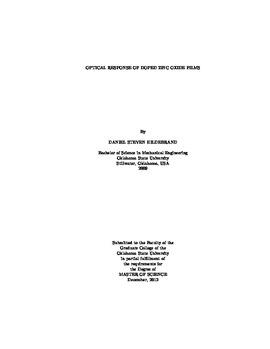| dc.contributor.advisor | Lucca, Don A. | |
| dc.contributor.author | Hildebrand, Daniel Steven | |
| dc.date.accessioned | 2014-04-17T20:12:38Z | |
| dc.date.available | 2014-04-17T20:12:38Z | |
| dc.date.issued | 2012-12-01 | |
| dc.identifier.uri | https://hdl.handle.net/11244/10316 | |
| dc.description.abstract | Re-doped ZnO thin films were deposited on c-plane and r-plane sapphire substrates using pulsed laser deposition (PLD). The effects of doping ZnO with Re were investigated using X-ray diffraction (XRD), Raman spectroscopy, and photoluminescence (PL) spectroscopy. Comparisons to bulk single crystal ZnO indicated the films were of high crystalline quality. It was revealed that low doping concentrations of Re (5-10 wt. % ReO2) increased the crystalline quality and decreased the residual compressive strain of the ZnO films. PL spectroscopy showed that the donor bound exciton emission increased in intensity, and a structural defect related peak, DBX, decreased in intensity. The Debye temperature of films doped with 5 wt. % ReO2 increased as calculated using the Manoogian-Woolley model. The ZnO E2high Raman peak increased in intensity relative to the Al2O3 substrate Raman peak and shifted to a lower wavenumber. Higher doping concentrations (10-50 wt. % ReO2) resulted in a decrease in crystalline quality and an increase in residual compressive strain. The intensity of the donor bound exciton emission decreased and the calculated Debye temperature decreased with increasing doping concentration. The E2high Raman peak decreased in relative intensity and shifted to a higher wavenumber. A plausible explanation for this behavior is that the Re ions substitute at Zn sites up to a certain saturation threshold, after which the number of Re ions found at interstitial sites increases. Additionally, the formation of precipitated ReO2 was detected by XRD for the 50 wt. % ReO2 film deposited on c-plane sapphire. The precipitate phase may begin to form at lower Re doping concentrations, and may contribute to the increase in residual compressive strain and decrease in crystalline quality of the ZnO films. | |
| dc.format | application/pdf | |
| dc.language | en_US | |
| dc.publisher | Oklahoma State University | |
| dc.rights | Copyright is held by the author who has granted the Oklahoma State University Library the non-exclusive right to share this material in its institutional repository. Contact Digital Library Services at lib-dls@okstate.edu or 405-744-9161 for the permission policy on the use, reproduction or distribution of this material. | |
| dc.title | Optical Response of Doped Zinc Oxide Films | |
| dc.type | text | |
| dc.contributor.committeeMember | Klopfstein, Matthew J. | |
| dc.contributor.committeeMember | Pagilla, Prabhakar R. | |
| osu.filename | Hildebrand_okstate_0664M_12514.pdf | |
| osu.college | Engineering, Architecture, and Technology | |
| osu.accesstype | Open Access | |
| dc.description.department | School of Materials Science & Engineering | |
| dc.type.genre | Thesis | |
| dc.subject.keywords | doped | |
| dc.subject.keywords | oxide | |
| dc.subject.keywords | photoluminescence | |
| dc.subject.keywords | raman | |
| dc.subject.keywords | spectroscopy | |
| dc.subject.keywords | zinc | |
